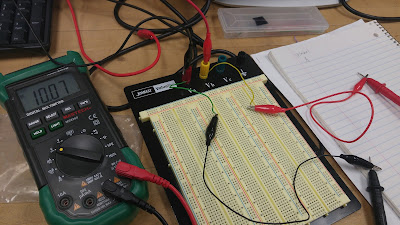|
With 5 V applied to a resistor in series with the
multimeter, the current was measures to be 40.8 Ma, which is in accordance with
ohm’s law, whereby the voltage divided by the resistance is equal to the
current (5 V /120 Ω = 41.7 mA). With the multimeter connected in series,
however, the current was measured to be 0 A because the resistor was shorted by
the multimeter, meaning current did not flow through it.
3. Apply 5 V to two resistors (47 Ω and 120 Ω) that are in series. Compare the measured and calculated values of voltage and current values on each resistor.
Measured Value
|
Calculated
Value
|
||
120 Ω
|
voltage
|
3.60 V
|
3.59 V
|
current
|
29.7 mA
|
29.9 mA
|
|
47 Ω
|
Voltage
|
1.42 V
|
1.41 V
|
Current
|
29.8 mA
|
29.9 mA
|
Calculated values and measure values for both resistance and
Voltage across each resistor in this circuit tended to math to within 1%
Measured Value
|
Calculated
Value
|
||
120 Ω
|
voltage
|
5.03 V
|
5.00 V
|
current
|
40.7 mA
|
41.7 mA
|
|
47 Ω
|
Voltage
|
5.03 V
|
5.00 V
|
Current
|
127 mA
|
148 mA
|
These measurements were less consistent with the theoretical
values than for the same components connected in parallel. There are many
possible reasons for this. For instance, wires could have had a resistance
value that was not negligible as the calculations assume. It is also possible
that components came in contact that shouldn’t have, thus limiting the accuracy
of the reading.
a. Current on 2 kΩ resistor,
Picture 1: Current going through the 2k resistor
The measured current value for the 2k resistor was 2.06 mA and the
measured value for the current was 2.5 mA.
Picture 2: Voltage going through the 1.2k Resistor at the node with the 2k Resistor
Picture 3: Voltage going through the 1.2k Resistor in the middle of the circuit
The 1.2k Resistor connected to the 2k and 100 ohm node
has a measured voltage value of .85 volts and a calculated voltage value of .78
volts. The 1.2k resistor in the middle of the circuit has a measured voltage of
.717 volts and a calculated value of .733 volts. The lower voltage makes sense because
there is more resistance before the voltage meets the second 1.2k resistor.
6. What would be the equivalent resistance value of the circuit above (between the power supply nodes)?
Equivalent resistance: 2520 Ω
By taking observing that the 1k and 1.2 k Ω
resistors in the upper right hand corner of the above figure are in parallel,
their equivalent resistance can be calculated to be 545.5 Ω. This equivalent
resistance is in series with the 100 Ω resistor in the upper left hand corner,
and the combined resistance is found through simple addition to be 645.5 Ω.
This is in parallel with the second 1.2 k Ω resistor, so the combined
resistance is 419.7 Ω. Finally, this is in series with the 2k and 100 Ω
resistors, and these are added together for a final resistance value of 2520 Ω.
The equivalent resistance measured without the power supply was
3.19 k Ω. The resistance measured
with the power supply, on the other hand, did not remain at one value and
fluctuated wildly instead. This difference is because the voltage going through
the circuit interferes with the ability of the equipment to detect resistance.
8. Explain the operation of a potentiometer by measuring the resistance values between the terminals (there are 3 terminals, so there would be 3 combinations). (video)
Video 1: The different resistance values depending on the terminals attached
9. What would be the minimum and maximum voltage that can be obtained at V1 by changing the knob position of the 5 KΩ pot? Explain.
The voltages are the same no matter where the potentiometer knob is turned to, however the current and the resistance did change depending on the position of the knob. The current relying on the value of the resistance from the knob.
10. How are V1 and V2 (voltages are defined with respect to ground) related and how do they change with the position of the knob of the pot? (video)
Video 2: Voltage Through a Potentiometer Circuit
11. For the circuit below, YOU SHOULD NOT turn down the potentiometer all the way down to reach 0 Ω. Why?
Turning the resistance of the potentiometer all the way down to zero would allow for a high current to flow through the circuit that could damage the equipment and be dangerous. Resistance is essential to maintaining a level of current that is reasonable for the equipment. Without resistance wires could smoke or melt.
Video 3: Current Through 1k Ohm Resistor in Series with Potentiometer
Video 4: Current through 10 k Ohm Pot in Series with 1k Ohm Resistor
13. Explain what a voltage divider is and how it works based on your experiments.
A voltage divider is a device in a circuit that creates an output voltage that is a portion of an input voltage. This is done by providing a resistance which will reduce the voltage at an output channel. The output voltage drop is then directly related to the impedance, or in our experiments, the resistance, because the circuit must satisfy Kirchov's voltage law.
14. Explain what a current divider is and how it works based on your experiments.
A current divider splits current between different branches
in the divider. The currents will always divide to reduce the energy spent.
Based on our experiment, when a resistor connected in a parallel circuit is changed, then the other resistor will be affected by the same amount as the
change.













